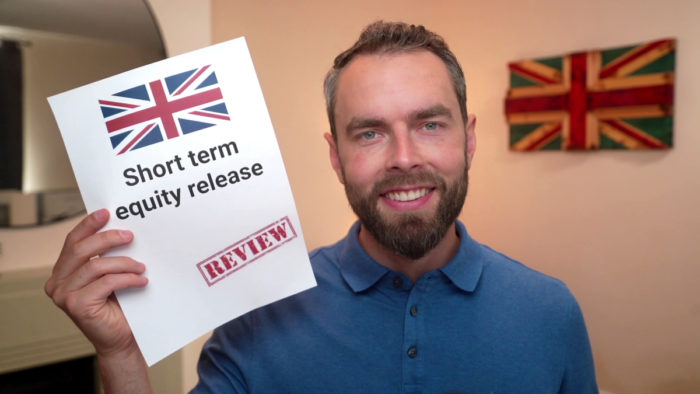Short Term Equity Release – Should You Do It?
Our preferred equity release adviser is Age Partnership. For free and impartial money advice you can visit MoneyHelper.

Our preferred equity release adviser is Age Partnership. For free and impartial money advice you can visit MoneyHelper.
“Are you keen to understand more about short-term equity release? You’re at the right spot. Each month, we help over 7,000 people understand equity release better. In this article, we’ll cover:
- What equity release is.
- Risks of releasing your home’s equity.
- How to get a realistic quote.
- What a lifetime mortgage and home reversion plan are.
- If short-term equity release is possible.
We know that the idea of equity release can be confusing. We get that you may have many questions about the process, but we’re here to help. We’ll offer lots of useful advice to guide you through the process as we understand your situation and aim to make things clearer step by step.
Let’s start our journey into understanding short-term equity release.”
Does it really exist?
If an equity release plan only has to be paid back after death or after moving into long-term care, how can short-term equity release plans exist? After all, you would need to see into the future to know when you need to move into care or know when you will die. That is why short term equity release doesn’t really exist, but there may be one exception. This exception is when certain people use an enhanced lifetime mortgage.
Are there short term methods?
Second charge mortgages and remortgaging to release equity usually involves large borrowing. In fact, both of these options might have minimum loan amounts of £10,000 or more. As the amount of credit borrowed is so large, they are unlikely to be classed as a short-term method of releasing equity for the majority of homeowners. However, it is not impossible for them to be short-term depending on the amount borrowed and the repayment period, which may be as short as a year.
What are other ways to do it?
Equity release schemes are not the only way of releasing equity from a property, although they may be the only option for seniors to release equity. The other ways people can release equity from a property are:
- Second charge mortgages
- Remortgaging to release equity
Second charge mortgages refer to home equity loans and other loans that are secured by home equity. They are added to a property with an existing first charge mortgage and repaid separately, often to a different lender.
On the other hand, remortgaging to release equity is switching your current mortgage to a bigger mortgage, using your home equity as a way to secure more credit. The additional money beyond what needs to be repaid to the first mortgage lender is paid out as a lump sum to be spent as desired.
How equity release could help
More than 2 million people have used Age Partnership to release equity since 2004.
How your money is up to you, but here’s what their customers do…
Find out how much equity you could release by clicking the button below.
In partnership with Age Partnership.
What are the different types?
The two main equity release schemes are home reversion plans and lifetime mortgages. Home reversion plans are usually the same across lenders, whereas there may be more variety of lifetime mortgages.
Lifetime mortgage
The standard lifetime mortgage allows the senior homeowner to access up to 60% of their home equity on their main residence as long as it has no existing mortgage and is worth at least £70,000 (in most cases). The money released is charged with a fixed interest rate for the entirety of the mortgage, i.e, until death or moving into care. The interest on a lifetime mortgage does not need to be repaid but instead rolls up, creating a bigger debt over time.
Home reversion plan
Home reversion equity release plans do not charge the homeowner any interest. Instead, the homeowner must agree to give a percentage of the home’s future sale proceeds to the lender. The amount they agree to is usually more than double the amount of equity they take out. And if the property increases in value, they end up paying back even more. For example, you may release 20% home equity but give up 50% of the future sale money.
What is the best type?
After hearing about both types of equity release plans, you may be inclined to think home reversion plans are the more expensive. But in reality, they can be both as expensive as each other. The equity release with a lifetime mortgage can more than double after 10-15 years with a standard interest rate.
The most common type of equity release plan in the UK is a lifetime mortgage. This might be because voluntary interest repayments are possible, which can therefore keep the debt lower over time.
Join thousands of others who release equity
Age Partnership have helped over 2 million people release equity from their home.

Mrs Wareham
“I am more than pleased to have taken out Equity Release with Age Partnership.”
Reviews shown are for Age Partnership. Search powered by Age Partnership.
What are the pitfalls?
The biggest pitfall of equity release is not getting appropriate advice and not choosing a lender that is a member of the Equity Release Council (ERC). By choosing an ERC member, you receive greater assurances, such as the negative equity guarantee and permission to move home in the future.
Quick recap
Short term equity release isn’t really possible because it is usually paid back after death. Unless you know when you will die and that you will die soon, then equity release can never be short term. The only time when it may be short term is if you have a terminal illness, in which case you could benefit from an enhanced lifetime mortgage.
Second charge mortgages and remortgaging to release equity are both more likely to be short term methods of releasing equity (not the same as equity release plans!). However, even in these cases, they are unlikely to be considered short-term borrowing.


